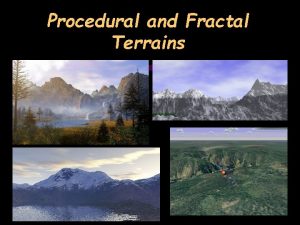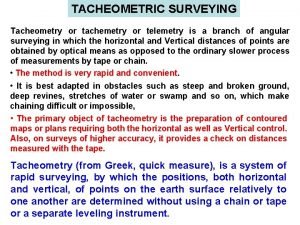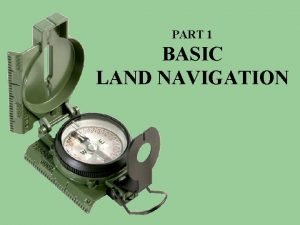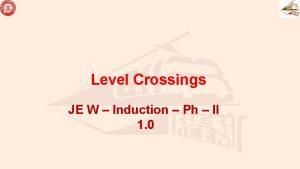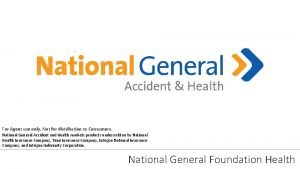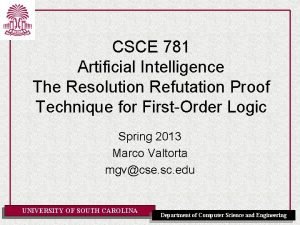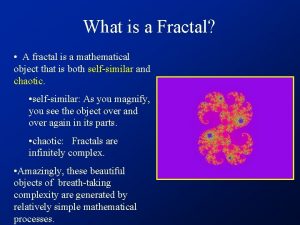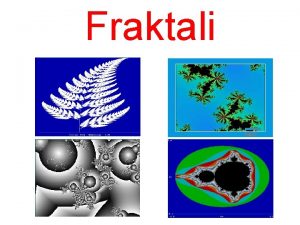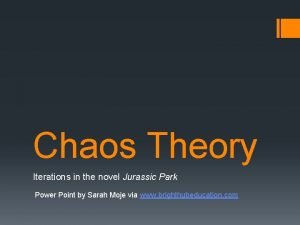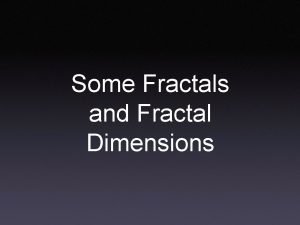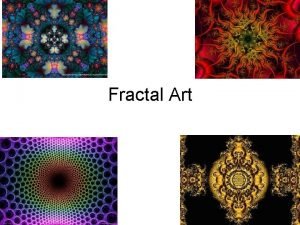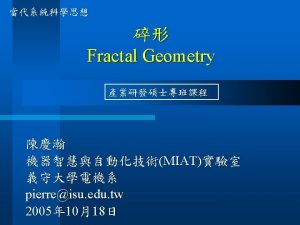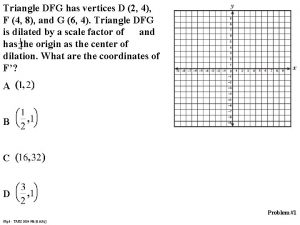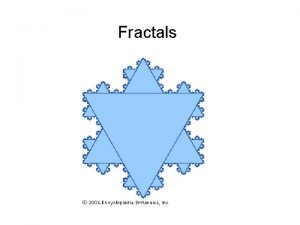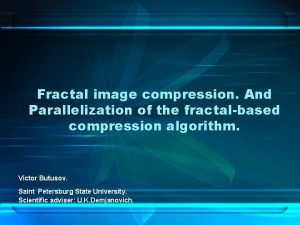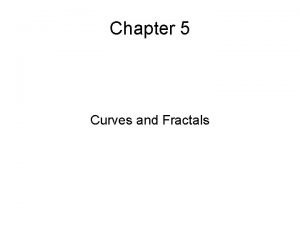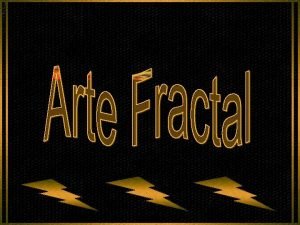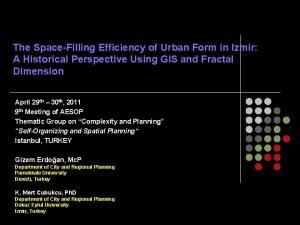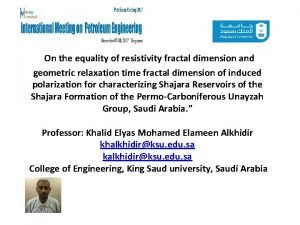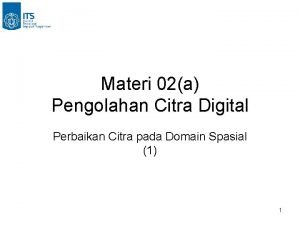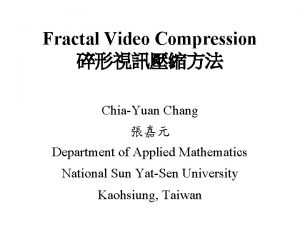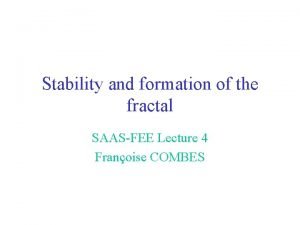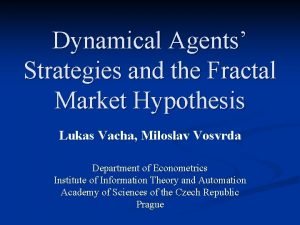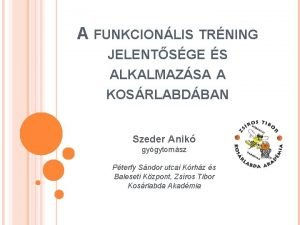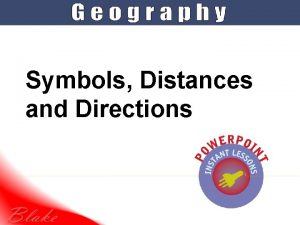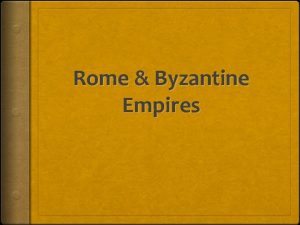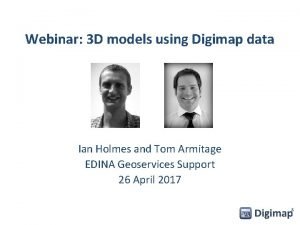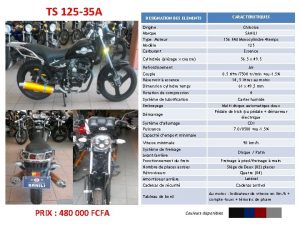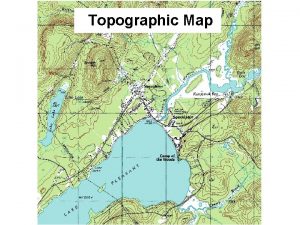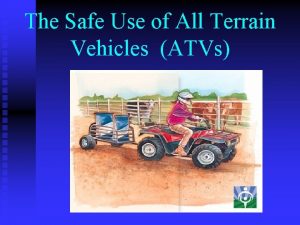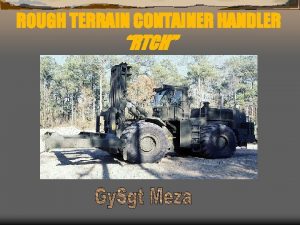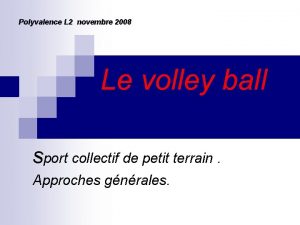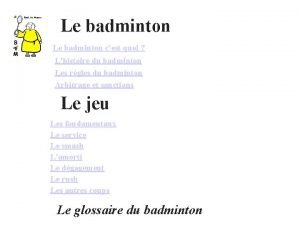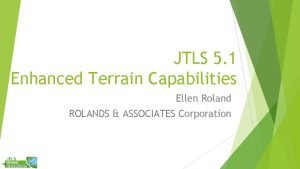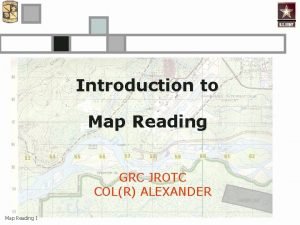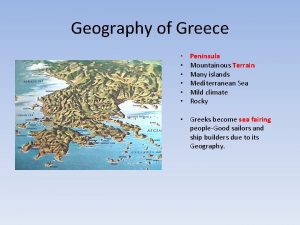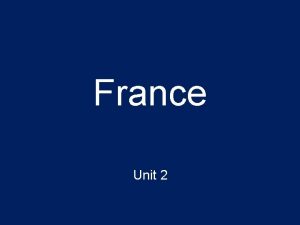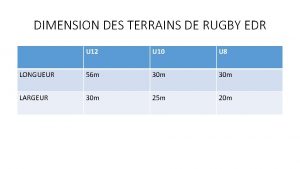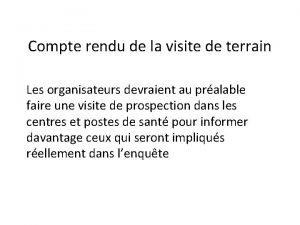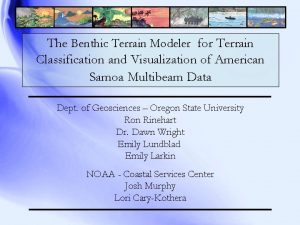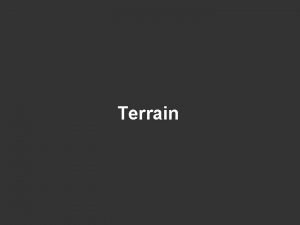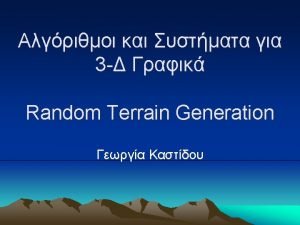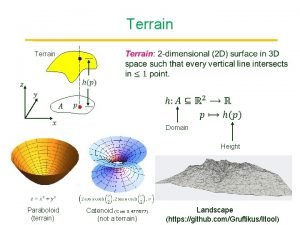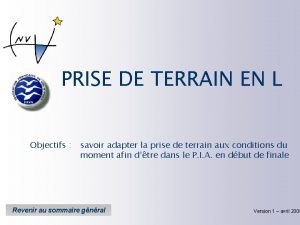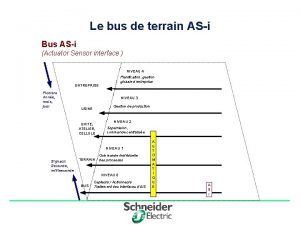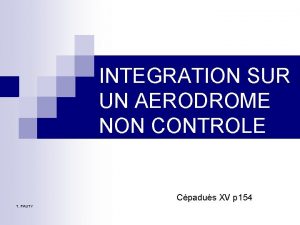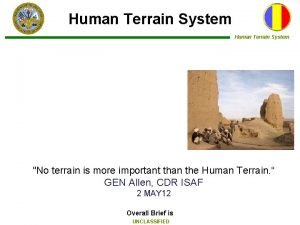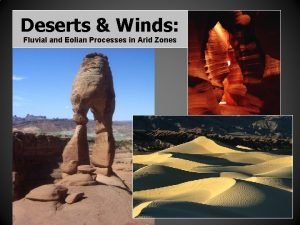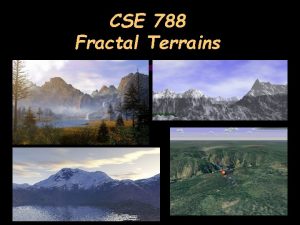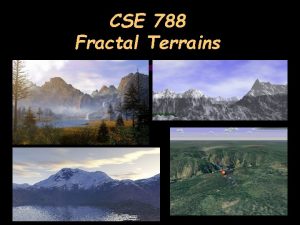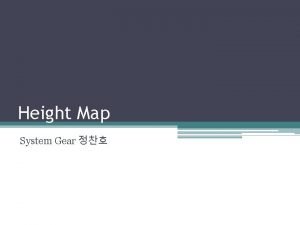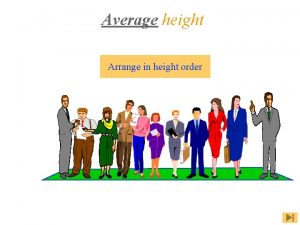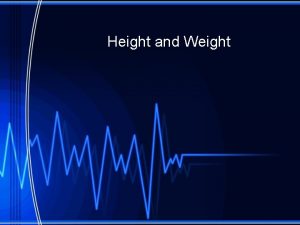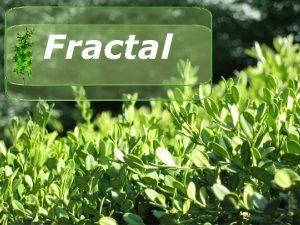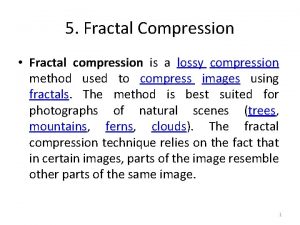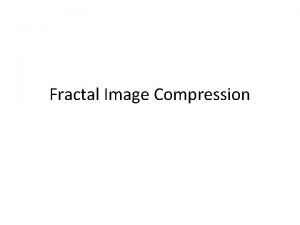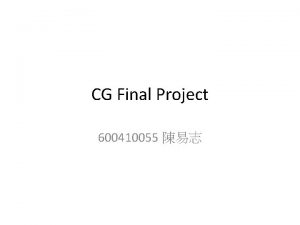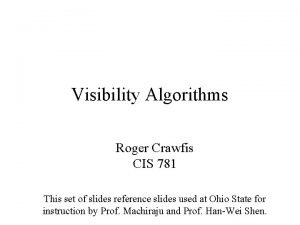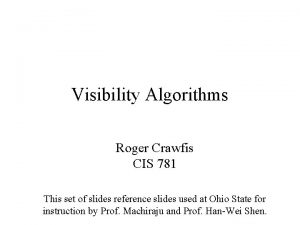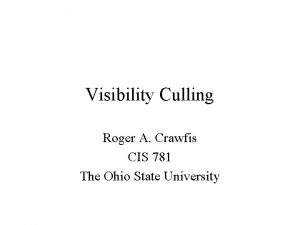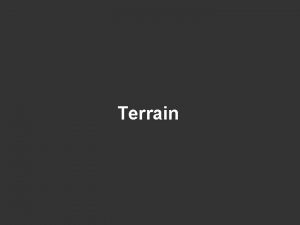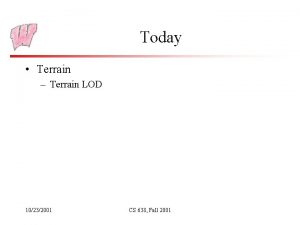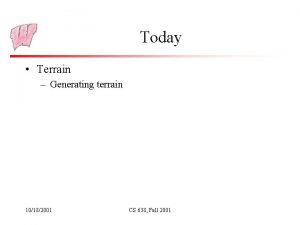CIS 781 Fractal Terrains Terrain Map Height Map
























































- Slides: 56

CIS 781 Fractal Terrains

Terrain Map • Height Map z = f(x, y) x and y are sampled on a 2 D integer grid – Real data : Satellite, Elevation maps – Synthetic : Texture map, Noise functions

Terrain Map • Connect samples into a mesh

Terrain Map • Natural looking – Model high detail – Size • Storage (Millions of polygons) • Rendering speed – Zoom-in, zoom-out (does not scale well) • Use textures to model detail? • Not real geometry (bump mapping at silhouettes) • Not scale independent • Repeated textures do not work well

Fake Terrain • Generate the heightfield • Random process • Reflects “realistic” terrain in some way

Random Terrain • Simple: – Terrain(x, y) = rand( MAX_HEIGHT ) – Results in random noise • Next step: – Smooth the terrain generated above – FIR filter: 1 1 1 1 1 R

Filtering • FIR (Finite Impulse Response) filter: – Pass a “window” over the data – Multiply data in window by weights • Result = d 1*w 1 + d 2*w 2+ … + d. N*w. N – Window + weights is called “filter kernel” – Larger window grabs more data

Random Fault Lines • Repeatedly: – Create a line that crosses terrain – Add d. Height offset on one side of line – d. Heighti = d. Height 0 + (i/n)(d. Heightn -d. Height 0) – Select random endpoints to generate line • Compute “side of line” by plugging X, Y into line equation +d. Height

More Realistic Faults • Apply FIR filter to faulted heightmap • Smooth out abrupt fault transitions: “Erosion”

Particle Deposition • Drop particles in areas where you want volcanic mountains • Particles flow downhill until they have cause to rest • Move the drop point to create interesting peak

Particle Deposition • Flow computation – At given point, find lowest neighbor – If local geometry is not flat enough, move new particle on top of lowest neighbor • Roll down hill – “Flat enough” = 27 degrees or so – Check 3 x 3 pixel window or 5 x 5 to check neighbors.

Particle Deposition

Perlin Noise • Using a sampling of 2 D perlin Noise provides smooth hills.

Terrain Coloring • Using a 1 D texture map based on the altitude can provide many useful mapping.

Terrain Coloring • Striped 1 D texture map.

Terrain Coloring • Using a 2 D texture map provides richer detail, but is independent of the terrain.

Terrain Coloring • More advanced coloring is based on altitude and slope.

Rolling Hills • Scaling in one dimension gives smooth rolling hills.

Procedural Modeling With Fractals • Procedural Modeling – Compute geometry “on-the-fly” • Fractals – Model Natural Phenomena - Self Similarity • Mountains, fire, clouds, etc. – Scales to infinity • Add or “make up” natural looking details with mathematical tools

Fractals “Repetition of form over a variety of scales” • Mandelbrot set, Julia set

Two Fractal Properties • Self-similarity

Two Fractal Properties • Fractal Dimension – Euclidean dimensions : 1, 2, 3, 4, … – Fractal : 1. 2342, 2. 7656 – Measure of detail or roughness of a fractal D = (ln N)/(ln 1/s)

Midpoint Subdivision • Midpoint (recursive) subdivision

Midpoint Subdivision • Brownian Motion – Describes random movement of particles in a gas or fluid • Fractional Brownian Motion – Brownian Motion + Fractal Dimension – A useful model for natural phenomena

Fractional Brownian Motion • Fractional Brownian Motion – Equations are compute intensive – Approximate with “A family of 1 D Gaussians ” • Zero mean • Standard Deviation : S = k 2 -i. H H = fractal dimension (roughness)

Fractional Brownian Motion • Fractal dimension = roughness, I. e. H

Terrain Modeling Criteria • Input – Initial coarse mesh + stochastic parameters • Two criteria – Internal Consistency • Reproducibility : Model is independent of position and orientation • Associate “random numbers” to point index – External Consistency • Continuity between adjacent primitives

Fractal Mountains • Fournier & Fussell (1980) • Recursively subdivide geometry by random number d: –d. Height/2 < d. Height/2 • At each recursion: – – 2 -r d. Height *= r=1 : self-similar r>1 : large features early r<1 : large features late A B A B

Triangle Subdivision • Subdivide a triangle into 4 triangles at edge midpoint

Quadrilateral Subdivision • Subdivide a quad into 4 quads at edge midpoints and a new center point.

Diamond-Square Subdivision • Alternate subdivision

Fractal Terrain

Mesh Subdivision • Square-square Subdivision – Addresses “creasing problem” (slope discontinuities) • Subdivide parametric patches

Mesh Subdivision • Displacement is scaled by the recursion level. – | b – a | -rn • When do you stop the recursion? – Pixel resolution • Displace upward, or towards the normal to the surface?

Mesh Subdivision • External Consistency – Avoid tears between neighboring polygons – How do we compute the normals? • Average polygon normals at each vertex. • Propagate normals down the recursion • Cheaper : use the original mesh normals only

Ridged Fractal Terrains • To create sharp peaks, add an absolute value and flip the surface upside down. • Or, reflect about a maximum value. • Provides a volcano-like effect.

Caldera

Multi-Fractal • This produces a ridged multi-fractal

Add a 1 D Texture

More Controls • To create plateaus, add a min function to flatten out high areas.

More Controls • To create a plain, add a max function to flatten out low areas.

More Controls • Multiply by a Guassian to limit the mountain range.

More Controls • To create valleys, create a lower amplitude and rather smooth terrain to use as the max operator.

max (Fractal, Smooth Noise)

max (Fractal, Smooth Noise)

Ridges • Quantize a terrain to create ridges – Use directly or as the min function. – Can also be done as a transfer function that maps f(x)->g(x). New height

Ridges

Other techniques • Cracked terrains for dry lakes and riverbeds. • Throw random points onto the plane. • Construct the Voronoi diagram and use the graph to etch into the terrain.

Cracked Terrains Crawfis, 2002

Fractal Terrains • Multifractals

Fractal Terrains • Color, texture

Fractal Terrains

Erosion - Higher-level control • Musgrave, et al. “The Synthesis and Rendering of Eroded Fractal Terrains”, Siggraph 1989. • Hydraulic Erosion – Water (rain) depositing to settle in height field • Thermal Weathering – “Any material that knocks material loose, which then falls down to pile up at the bottom of an incline. ”

Erosion

Erosion by water

Erosion by wind and water
 Fractal terrains
Fractal terrains Tacheometric distance equation on flat and sloped terrains
Tacheometric distance equation on flat and sloped terrains Saddle land nav
Saddle land nav Tvu of level crossing
Tvu of level crossing National general foundation health
National general foundation health Ai 781
Ai 781 Calhr 781 form
Calhr 781 form Ngic 888-781-0585
Ngic 888-781-0585 What is a fractal
What is a fractal Fractals
Fractals Jurassic park fractal
Jurassic park fractal Cantor set fractal dimension
Cantor set fractal dimension How to make fractal art
How to make fractal art What is a fractal
What is a fractal Universo fractal
Universo fractal What is the area of triangle dfg
What is the area of triangle dfg What does it mean?
What does it mean? Fractal image compression example
Fractal image compression example What are curves in computer graphics
What are curves in computer graphics Arte fractal
Arte fractal Space filling fractal
Space filling fractal Fractal dimension definition
Fractal dimension definition Fractal
Fractal Chia compression
Chia compression Point processing
Point processing Fractal saas
Fractal saas Fractal market hypothesis
Fractal market hypothesis Proprioceptor
Proprioceptor Hill valley ridge saddle depression
Hill valley ridge saddle depression Spot height symbol
Spot height symbol Heightmap raw
Heightmap raw Byzantine empire geography
Byzantine empire geography Height vs shoe size
Height vs shoe size Os terrain 5 dtm
Os terrain 5 dtm Origine
Origine Minor terrain features
Minor terrain features All terrain vehicle towing capacity 1050lbs
All terrain vehicle towing capacity 1050lbs Rough terrain container handler
Rough terrain container handler Terrain volleyball dimension
Terrain volleyball dimension Terrain de badminton
Terrain de badminton Ellen roland
Ellen roland 2 supplementary terrain features
2 supplementary terrain features How to orient a map using a lensatic compass
How to orient a map using a lensatic compass Greece terrain
Greece terrain Terrain in france
Terrain in france Dimension stade de rugby
Dimension stade de rugby Rapport de visite de terrain
Rapport de visite de terrain Benthic terrain modeler
Benthic terrain modeler Terrain
Terrain Opengl terrain generation
Opengl terrain generation The terrain domain
The terrain domain Prise de terrain en u
Prise de terrain en u Bus asi
Bus asi Data terrain
Data terrain Integration circuit aerodrome
Integration circuit aerodrome Human terrain system
Human terrain system Eiloan
Eiloan
